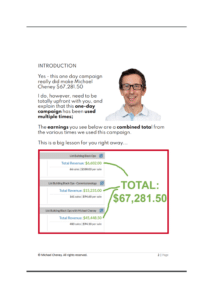Placing links to products you recommend on your site, is an easy way to generate revenue from your blog without creating and shipping your own products. However, simply adding a few affiliate links to your posts won’t necessarily lead to sales and commissions. You need to strategically place calls-to-action and affiliate links to convert readers into customers.
This article will explore how to effectively integrate affiliate links into your content to maximise your earning potential. You’ll learn research-backed techniques for prominently featuring products in a way that resonates with your audience and drives them to click through and buy. With the right approach, affiliate marketing can become a steady source of income from your blog, allowing you to continue creating content for your readers while still being able to monetize your efforts.


If you’ve been struggling online this report will open your eyes.
Introduction to Monetizing Your Blog With Affiliate Links
Building an Audience and Generating Traffic
To effectively monetize your blog with affiliate links, you first need to build an audience and generate consistent traffic. There are several ways to do this:
•Focus on high-quality and helpful content. Publish useful posts, tutorials, reviews and resources that provide value to your readers. Content that solves problems or answers questions is particularly effective for building trust and loyalty.
•Optimize for search engines. Use relevant keywords, internal linking, and fast page load times to improve your search ranking. High rankings in search engines like Google will drive organic traffic to your site.
•Be active on social media. Promote your latest posts on platforms like Facebook, Twitter, LinkedIn, and Pinterest. Engage with followers by liking and commenting on their posts as well. Social media is a great way to increase brand awareness and connect with potential readers.
•Start an email newsletter. Build up a mailing list so you have a direct line of contact to your audience. Send regular newsletters highlighting your new posts to drive traffic to your site. Offer a lead magnet like a free resource to encourage signups.
•Guest post on other sites. Pitch guest posts to blogs and websites in your niche with a larger following. Include a short bio and link back to your own site. This expands your reach and exposes you to new potential readers and subscribers.
•Run contests and giveaways. Contests and freebies are an excellent way to increase shares, links, and buzz around your blog. They also give you an opportunity to collect email addresses for your mailing list. Keep the entry rules simple and offer a prize that would appeal to your target audience.
With consistency and persistence, focusing on these core strategies will help build a loyal readership, increase traffic, and prime your blog for monetization through affiliate links and other revenue streams.

Become the Internet Marketing Millionaire’s Next Apprentice!!
Strategic Affiliate Link Placement for Higher Conversions
To maximise affiliate link conversions on your blog, strategic placement and optimization are key. Carefully consider where you embed affiliate links in your content for the best results.
Headline and Opening Paragraph
Include an affiliate link in the headline or opening paragraph of a blog post. Readers are most engaged here, so they are more likely to click through. However, use links sparingly in headings to avoid looking spammy.
Product Reviews and Recommendations
If you are reviewing or recommending a product, place an affiliate link prominently near the beginning of the review, such as after the product name or photo. Reiterate the link at the end of the review or recommendation as a call to action. These locations capture readers when interest in the product is highest.
Middle of Content
Embed 1-2 affiliate links in the middle of your blog content, such as after making a strong point about the benefits or usefulness of a product. Make sure the link is relevant and flows naturally within the content. Too many links can seem promotional and turn readers off.
Bulleted/Numbered Lists
Affiliate links included in bulleted or numbered lists also tend to have higher conversion rates. Readers expect links in lists, and the visual formatting draws attention to the links. However, do not turn your entire blog post into a list just to include more links. Keep your content balanced and the links relevant.
With strategic affiliate link placement optimised for higher conversions and an authentic, value-driven approach to promoting products, you can boost your affiliate revenue and build a sustainable income stream from your blog. But never forget – content is king. Focus on quality and your readers first.

Writing Persuasive Affiliate Link Copy
To generate affiliate revenue from your blog, you must persuade readers to click on and purchase products through your affiliate links. Crafting compelling copy for these links is key.
Highlight the Benefits
Focus on emphasising the benefits and value to the reader rather than just describing product features. For example, say “Get up to 50% more battery life so you can work on the go without worrying about finding an outlet” rather than just “High-capacity, fast-charging lithium-ion battery.” Benefit-focused copy helps readers understand what’s in it for them, piquing their interest.
Build Trust
Establish your credibility by mentioning your own positive experiences with the product or your expertise in that market sector or product category. For example, say “As an avid wildlife photographer, I’ve found that these camera lenses produce unparalleled image quality for stunning nature shots.” References to your first-hand experiences or expertise make you seem like a trusted source.
Use Power Words
Incorporate power words and phrases like “best”, “leading”, “top-rated”, “award-winning”, “revolutionary” or “groundbreaking” to convey the superior qualities and performance of the products. For example, say “The award-winning ABC123 is the best professional 4K video drone on the market.” Powerful language gives readers the impression that a product is an exceptional choice.
Offer Incentives
Promote limited-time offers, discounts, free shipping, or other incentives to motivate readers to click and buy through your link immediately. For example, say “For a limited time, get 10% off your first order of premium ABC123 camera lenses – but hurry, this offer ends Friday!” Incentives create a sense of urgency and value that can prompt readers to take action right away.
Using persuasive copy tactics like highlighting benefits, building trust, employing power words, and offering incentives in your affiliate link copy can significantly impact conversion rates and boost your earnings from product recommendations on your blog. Keep testing different messages and optimising your approach to continue improving your results over time.
Driving Traffic to Affiliate Links Through Email Marketing
4. Driving Traffic to Affiliate Links Through Email Marketing
An effective way to drive more traffic to your affiliate links is through email marketing. By building an email list of blog readers and subscribers and sending regular updates, you can direct people back to your affiliate content and offers.
Grow Your Email List
The first step is to build up your email list by offering an opt-in incentive like a free resource, checklist or cheat sheet. You can promote your email list sign-up in your blog sidebar, in post content, or by using a pop-up. Offering useful, relevant content or resources to your target audience will encourage people to subscribe to your list.
Send Valuable Email Content
Once you have subscribers, send a regular email newsletter with curated content from your blog. You might send one email per week or per month depending on your publishing schedule. Include snippets or summaries of your latest posts and be sure to link back to the full posts on your blog. This exposes your email subscribers to your affiliate links and content on an ongoing basis.
Promote Affiliate Offers and Deals
In addition to your regular content updates, send dedicated emails promoting any hot deals, time-sensitive offers or big sales for your affiliate programmes. Explain the benefits and value to your subscribers and be transparent that these are affiliate links. Many people are happy to use your links if you’ve been providing them with useful information and resources.
Track and Optimise
Use an email service provider to send your newsletters and monitor metrics like open rates, click-through rates and unsubscribes. See which types of content and offers resonate best with your list. Make changes to improve your subject lines, content and frequency based on the stats. Over time, a well-optimised email marketing strategy can become one of the top sources of traffic and affiliate revenue for your blog.
Continually growing your list size and nurturing your relationships with subscribers will maximise the potential of your email affiliate marketing efforts. With regular, value-driven communications, you can achieve high open and click rates which translate into more traffic and sales for your affiliate links.
3 Necessary Tools for your Affiliate Marketing Business(Opens in a new browser tab)
Tracking Affiliate Link Performance to Improve Conversions
To effectively monetize your blog through affiliate marketing, you must track the performance of your affiliate links to determine what’s working and not working. ### Link Placement
Where you place affiliate links on your blog posts and pages significantly impacts conversion rates. Test different locations to find the optimal position for each link. Some of the most common placements include:
- Within the content – Place links within blog posts, especially after mentioning a product. This makes it easy for readers to click through and purchase.
- Sidebar – Links in your blog sidebar are prominently displayed on every page. However, they may be overlooked by some readers.
- After content – Place a link or call to action after your post content to capture readers while the topic is still fresh in their minds.
- End of post – Links at the very end of your post, especially on how-to or list posts, perform well since you’ve established yourself as an authority on the topic.
Link Design
How your affiliate links look also affects performance. Some best practises include:
- Use anchor text that describes the product or offer. For example, say “Buy this essential oil diffuser” rather than just “click here.”
- Make links visually distinct from regular text using colour, bolding or underlining. But don’t overdo it, or it may seem spammy.
- Use tracking software to see click-through and conversion rates for each link. Then you can optimise or remove underperforming links.
Offer Incentives (Optional)
To boost conversion rates, you might offer incentives for clicking your affiliate links such as coupon codes, giveaways or bundle deals. Be transparent that the links are affiliate links to build trust with your readers.
Continually analysing how your readers interact with your affiliate links and making improvements to placement, design and offers will significantly impact your affiliate marketing earnings over the long run. Paying close attention to link performance and optimising accordingly is key to success.
Conclusion
In order to successfully monetize your blog through affiliate marketing, you must carefully consider where and how you place your affiliate links and how to optimise your content for conversions. As you have seen, strategic link placement and optimised CTAs can have a significant impact on your earnings potential. However, the most important thing to keep in mind is to always provide value to your readers first. Focus on creating high-quality, helpful content and building a trusting relationship with your audience. When done right, affiliate marketing should be an organic way to generate revenue from content you were going to create anyway. With consistent effort and optimization over time, affiliate marketing can become a meaningful income stream for any blogger.